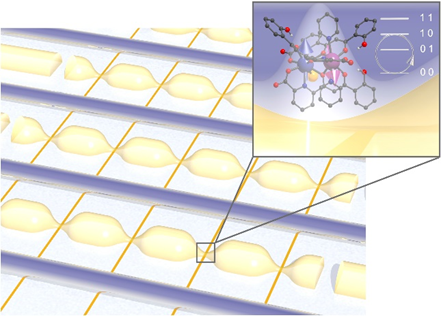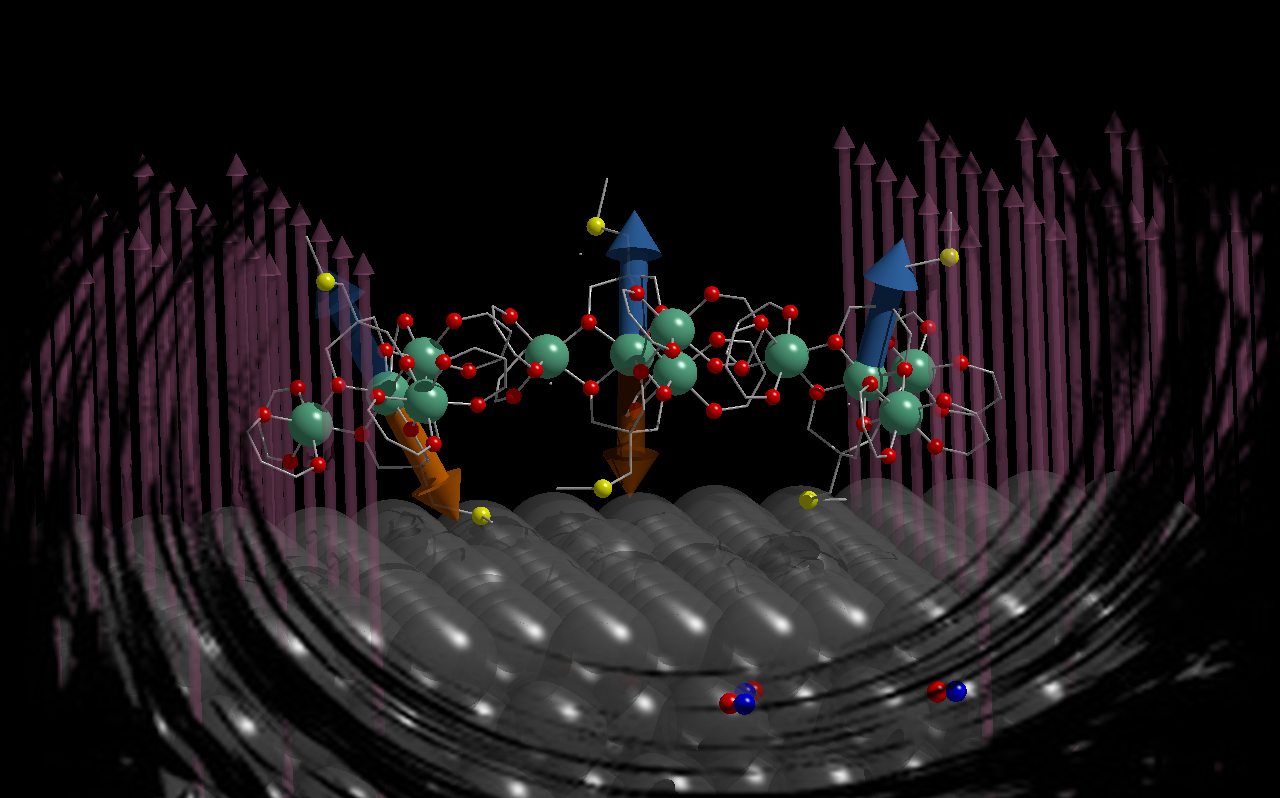SUMO
SUMO aims to set the basis of a new architecture for q uantum computation and simulation, in which information is encoded in molecular spin qubits that are read-out and communicate by coupling to a superconducting resonator. This technology has a high scalability potential based on the microscopic and reproducible nature of the molecules and on the possibilities they offer for embodying multiple qubits, which provide an extra dimension to increase computational resources and to implement noise-resilient
uantum computation and simulation, in which information is encoded in molecular spin qubits that are read-out and communicate by coupling to a superconducting resonator. This technology has a high scalability potential based on the microscopic and reproducible nature of the molecules and on the possibilities they offer for embodying multiple qubits, which provide an extra dimension to increase computational resources and to implement noise-resilient
 |
logical qubits. The proposal focuses on two specific targets, which are crucial milestones for the realization of such magnetic quantum processor. The first is the implementation of active quantum error correction in magnetic molecules. The second is the attainment of strong coupling between individual molecular spins and single microwave photons It has a strong multidisciplinary character and benefits from the European leadership in molecular magnetism.
Already more than a decade ago, it was realized that one of the magnetic molecules’ fortes was the possibility of using their spin states to realize more than just single qubits.1 Recent years have brought these ideas to reality, as molecular2-4 and supramolecular5-7 structures hosting multiple addressable qubits have been prepared. In addition, new theoretical schemes for exploiting such structures to process quantum information have been put forward.8 Pessimistic views associated with the short spin coherence times, at least compared with those of impurity defects in semiconductors,9 have dissipated as rational strategies for beating decoherence have enabled reaching T2 close to milliseconds.10-12 In this proposal we build on this progress to implement in artificial molecules the unit cell of a fault-tolerant quantum computer, namely logical qubits able to detect and correct errors. Specifically, molecules with three qubits can realize the simplest 3-qubit repetition codes whereas molecules with seven qubits can implement Steane or topological colour codes.13,14 One can also think of adding additional ancilla qubits to perform quantum non-demolition measurements of the error syndromes.
Unleashing the potential of these molecular chips and, in particular, implementing some algorithm (e.g. a QECC) requires however moving from experiments in molecular ensembles to the control of single molecules.15,16 In recent years, electron transport measurements have provided information on the magnetism of individual molecules. Here, we explore the electronic structure, the spin relaxation and the spin coherence of single molecules deposited onto superconducting substrates by means of time-resolved inelastic electron tunneling experiments.17 But it needs also moving to the single-photon limit. The coupling G of each molecule to a superconducting resonator serves to read-out its spin state and to generate effective couplings with other molecules in the circuit.16 This technology, standard with superconducting qubits,18,19 is however challenging for spin qubits (molecular or not). Typical magnetic couplings are of the order of a few Hz, thus far from the strong coupling regime G>1/T2 for even the best molecular qubits. Creating an optimum interface between the two systems represents therefore a major technological roadblock that has to be overcome to create a fully operative platform. Our approach is to develop new superconducting devices, scaled down at some specific areas to the nanoscopic molecular world. Despite its daunting inherent challenges, some recent breakthroughs invite to optimism. Theoretical simulations show that coherent coupling to single spins is attainable for device properties (dimensions and quality factors) that are within the reach of current nanotechnology.15,16 First prototypes of superconducting nanoresonators have been fabricated recently and shown to be operative.20 Molecules possess also some advantages that ease their transfer from the solid to a substrate and their integration in devices via selective functionalization as well as soft lithographic methods. Besides, it has been shown that suitable molecules preserve their properties under such conditions.21
- M. N. Leuenberger and D. Loss, Quantum computing in molecular magnets, Nature 410, 789 (2001).
- F. Luis, A. Repollés, M. J. Martínez-Pérez, D. Aguilà, O. Roubeau, D. Zueco, P. J. Alonso, M. Evangelisti, A. Camón, J. Sesé, L. A. Barrios, and G. Aromí, Molecular Prototypes for Spin-Based CNOT and SWAP Quantum Gates, Phys. Rev. Lett. 107, 117203 (2011).
- D. Aguilà, L. A. Barrios, V. Velasco, O. Roubeau, A. Repollés, P. J. Alonso, J. Sesé, S. J. Teat, F. Luis, and G. Aromí, Heterodimetallic [LnLn′] Lanthanide Complexes: Toward a Chemical Design of Two-Qubit Molecular Spin Quantum Gates, J. Am. Chem. Soc. 136, 14215 (2014).
- M. D. Jenkins, Y. Duan, B. Diosdado, J. J. García-Ripoll, A. Gaita-Ariño, C. Giménez-Saiz, P. J. Alonso, E. Coronado, and F. Luis, Coherent manipulation of three-qubit states in a molecular single-ion magnet, Phys. Rev. B 95, 064423 (2017).
- J. Ferrando-Soria, E. M. Pineda, A. Chiesa, A. Fernández, S. A. Magee, S. Carretta, P. Santini, I. J. Vitorica-Yrezabal, F. Tuna, G. A. Timco, E. J. L. McInnes and R. E. P. Winpenny, A modular design of molecular qubits to implement universal quantum gates, Nature Commun. 7, 11377 (2016).
- A. Fernández, J. Ferrando-Soria, E. Moreno-Pineda, F. Tuna, I. J. Vitorica-Yrezábal, C. Knappke, J. Ujma, C. A. Muryn, G. A. Timco, P. E. Barran, A. Ardavan, and R. E. P. Winpenny, Making hybrid [n]-rotaxanes as supramolecular arrays of molecular electron spin qubits, Nature Commun. 7, 10240 (2016).
- A. Ardavan, A. M Bowen, A. Fernández, A. J Fielding, D. Kaminski, F. Moro, C. A. Muryn, M. D Wise, A. Ruggi, E. J. L. McInnes, K. Severin, G. A. Timco, C. R. Timmel, F. Tuna, G. F. S. Whitehead, and R. E. P. Winpenny, Engineering coherent interactions in molecular nanomagnet dimers, npj Quantum Information 1, 15012 (2015).
- P. Santini, S. Carretta, F. Troiani, and G. Amoretti, Molecular Nanomagnets as Quantum Simulators, Phys. Rev. Lett. 107, 230502 (2011).
- D. D. Awschalom, L. C. Bassett, A. S. Dzurak, E. L. Hu and J. R. Petta, Quantum Spintronics: Engineering and Manipulating Atom-Like Spins in Semiconductors, Science 339, 1174 (2013).
- C. J. Wedge, G. A. Timco, E. T. Spielberg, R. E. George, F. Tuna, S. Rigby, E. J. L. McInnes, R. E. P. Winpenny, S. J. Blundell and A. Ardavan, Chemical Engineering of Molecular Qubits, Phys. Rev. Lett. 108, 107204 (2012).
- J. M. Zadrozny, J. Niklas, O. G. Poluektov, and D. E. Freedman, Millisecond Coherence Time in a Tunable Molecular Electronic Spin Qubit, ACS Cent. Sci. 1, 488 (2015).
- M. Shiddiq, D. Komijani, Y. Duan, A. Gaita-Ariño, E. Coronado and S. Hill, Enhancing coherence in molecular spin qubits via atomic clock transitions, Nature 531, 348 (2016).
- B. M. Terhal, Quantum error correction for quantum memories, Rev. Mod. Phys. 87, 307 (2015).
- D. Nigg, M. Müller, E. A. Martínez, P. Schindler, M. Hennrich, T. Monz, M. A. Martín-Delgado and R. Blatt, Quantum computations on a topologically encoded qubit, Science 345, 302 (214).
- M. D. Jenkins, T. Hümmer, M. J. Martínez-Pérez, J. J. García-Ripoll, D. Zueco and F. Luis, Coupling single-molecule magnets to quantum circuits, New J. Phys. 15, 095007 (2013).
- M. D. Jenkins, D. Zueco, O. Roubeau, G. Aromí, J. Majer, and F. Luis, A scalable architecture for quantum computation with molecular nanomagnets, Dalton Trans. 45, 16682 (2016).
- S. Loth, M. Etzkorn, C. P. Lutz, D. M. Eigler, and A. J. Heinrich, Measurement of Fast Electron Spin Relaxation Times with Atomic Resolution, Science 329, 1628 (2010).
- A. Wallraff, D. I. Schuster, A. Blais, L. Frunzio, R.-S. Huang, J. Majer, S. Kumar, S. M. Girvin and R. J. Schoelkopf, Strong coupling of a single photon to a superconducting qubit using circuit quantum electrodynamics, Nature 431, 162 (2004)
- J. Majer, J. M. Chow, J. M. Gambetta, J. Koch, B. R. Johnson, J. A. Schreier, L. Frunzio, D. I. Schuster, A. A. Houck, A. Wallraff, A. Blais, M. H. Devoret, S. M. Girvin, and R. J. Schoelkopf, Coupling superconducting qubits via a cavity bus, Nature 449, 443 (2007).
- M. D. Jenkins, U. Naether, M. Ciria, J. Sesé, J. Atkinson, C. Sánchez-Azqueta, E. del Barco, J. Majer, D. Zueco, and F. Luis, Nanoscale constrictions in superconducting coplanar waveguide resonators, Appl. Phys. Lett. 105, 162601 (2014).
- M. Mannini, F. Pineider, C. Danieli, F. Totti, L. Sorace, Ph. Sainctavit, M.-A. Arrio, E. Otero, L. Joly, J. C. Cezar, A. Cornia, and R. Sessoli, Quantum Tunneling of the Magnetization in a Monolayer of Oriented Single Molecule Magnets, Nature 468, 417 (2010).
